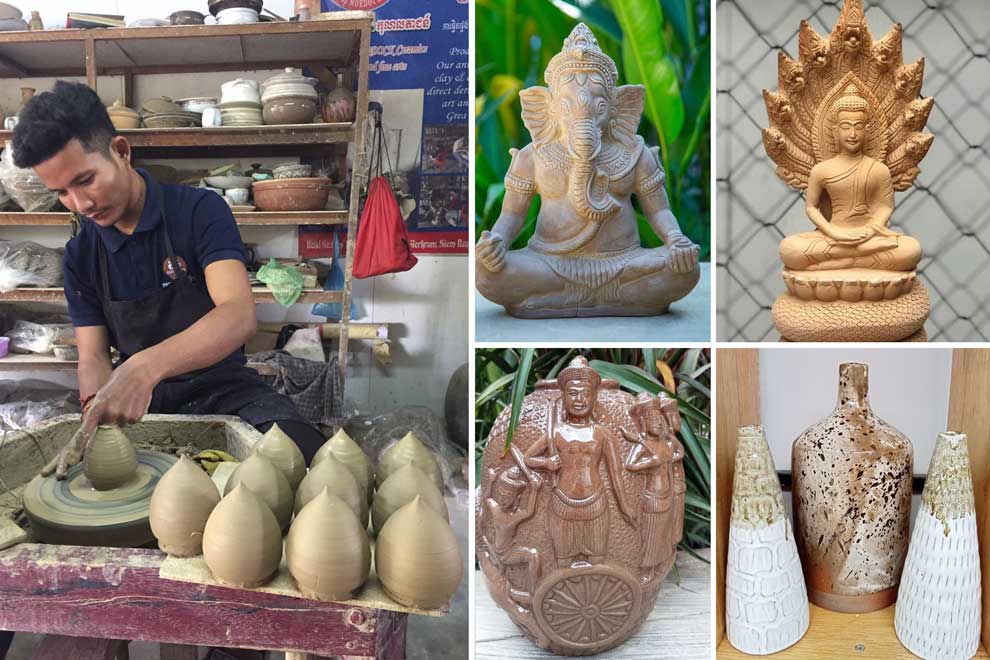
Son Sihak crafting ceramics products in his Siem Reap studio. FB
Clay pottery usually takes the form of pots and pans or kitchen utensils and occasionally items for home decoration done in simple and traditional forms. But a young man in Siem Reap is making mud into more beautiful and luxurious ceramics which are now being sold abroad.
Music from a phone blares over the top of the voices of a group of men and women as each of their ten fingers is busy forming pieces of clay on a long board that are destined to become ceramic items with a value of up to $500.
Son Sihak, the pottery proprietor, lives in Treang village of Slakram commune in Siem Reap town where his handicraft workshop is also located.
He told The Post that he was born in Andong Russey village and commune in Rolea Ba’ier district of Kampong Chhnang province. He said he learned his skills because they were passed down from his ancestors to his family and all of the villagers of Andong Russey as pottery is a traditional career and practice there, but most of them can only make simple inexpensive items.
The young man said that he was lucky because in 2003 his community was trained by a group of experts from Germany and Japan who taught them the techniques for making ceramic objects.
In his community at that time, only 20 people were trained in the ceramic techniques and of those he was the only one who mastered the necessary skills, while the others simply returned to the traditional practices once the teachers were no longer present.
According to Sihak, after 2003 he was hired by a French artisan to make ceramics and he moved from one province to another. Finally, he found his permanent place in Siem Reap and then he was promoted as to manage the staff and do the marketing for the shop until he resigned in 2015 to open his own business.
After he started his own business in 2015 things have been going well for him. Even during the Covid-19 pandemic his business has still been good due to the large number of customers ordering online.
Sihak said that in general he believes what has made him successful are the skills he inherited from his family combined with the training he received from the German and Japanese instructors.
He said that it is his passion to preserve the heritage of the Cambodian ancestors and he has also tried to do more research on what he learned from the German and Japanese trainers.
He’s also done some research on some ancient Khmer books and other books stored at the National Library. And he’s learned from following the instructions customers have given him for custom orders that were in a different style than what he was used to.
“There are a lot of ancient Khmer models in the books at our museums and in the Khmer ceramic books that we have compiled. On the other hand, my handicraft workshop functions well because I have the resources of my team,” he said.
Sihak added that he uses clay from Kampong Chhnang and Siem Reap provinces to make vases, bowls, glasses, cups, teapots, animal sculptures, statues and other ornaments.
Once the items are shaped, he bakes them in a gas and wood-burning kiln to form a smooth layer made of rock, ash and soil over them before he bakes them two more times – the first at 900 degrees for 10 hours and the second bakes at 1300 degrees and takes 16 hours to do this to make the material strong.
His products are now distributed across all 24 provinces and the capital with prices ranging from $1 to $500, depending on the item.
Foreigners also sell his products in Canada, Singapore, the US and Germany. Most of the products sold abroad are decorative items such as vases.
He added that his ceramic products decorated in Khmer style are also sold in five-star hotels, restaurants, cafes and massage parlours in the Kingdom. He now employs 14 male and female staff members, all of whom are trained professionals and are an important resource that helps make his handicraft successful every day.
Sihak said that if there is a suitable opportunity he would like to open a place to train the younger generation in ceramics so that they can learn from him and help preserve Khmer culture in the form of pottery forever.














